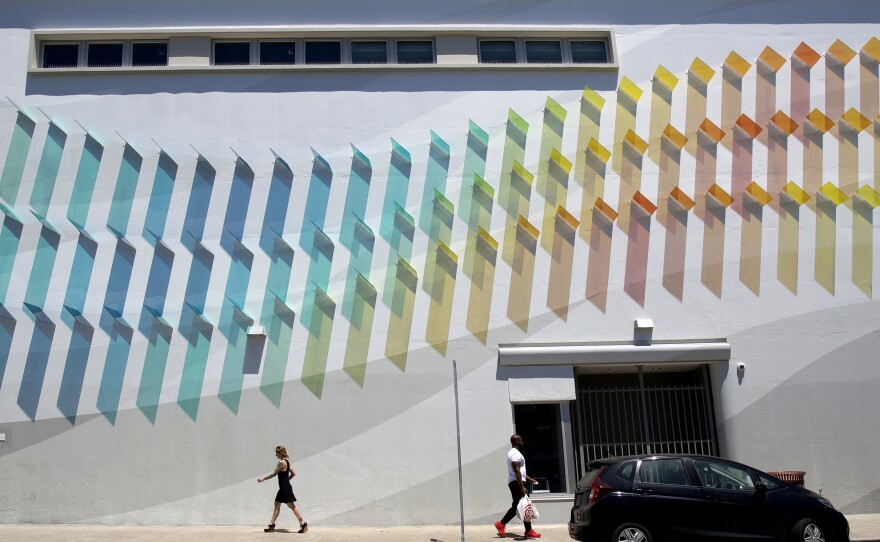In her sunny Rolando studio, Kaori Fukuyama cuts and arranges tiny slivers of dichroic film, jutting hundreds of pieces out from the wall in patterns that twist and loop.
She works with mostly clear plastics, acrylics and films that refract and transform light.
Fukuyama’s work is informed by the influential California Light and Space movement artists of the 1960s, like Peter Alexander or San Diego's own Robert Irwin.
Her first work of public art was on the outside of the small-format Target store in North Park, which opened in 2019. There, Fukuyama used large, translucent polycarbonate discs in a rainbow of colors that protrude from the wall in a massive wave. The pieces cast colorful shadows above pedestrians' heads as they walk near the intersection of University Avenue and Ray Street.

Since her first public project with Target, Fukuyama has completed a handful of other public art projects, including at the Southeastern Live Well Center, the Rolando Library, the Jacobs Medical Center and now, the San Diego International Airport.
"Honestly, I feel very fortunate that my first public art client was the private corporation," Fukuyama said. "In many ways, I'm learning now (while) working on a civic project, that there's a lot more flexibility with the private corporation — when it comes to especially budget."

Back in the studio, Fukuyama narrates her process as she assembles her new work of art with dichroic film.
"I make an incision, and then just stick this in here … I find my process very boring," she said, laughing.
It is fascinating to watch her work. Even in progress, shadows scatter brilliantly in countless directions and countless colors.

For this piece, Fukuyama was inspired by the movements of a group of starlings, or a "murmuration." Each bird communicates only with its seven closest neighbors, but somehow thousands of birds move flawlessly in intricate patterns.
For Fukuyama, the tumult of the last few years led her to connect the starlings' mumurations to community and humanity.
"We feel very overwhelmed, but just kind of focusing on your neighbors, your friends and your family and starting small, and that would create this ripple effect," Fukuyama said.

The new piece, "Undercurrent," will be on view at City College Art Gallery through Sept. 30.
"Undercurrent" is a revision of an installation currently on view at the San Diego International airport in a glass case before Checkpoint 6 — the airport's primary security line in Terminal 2. The work, "Farverig Sol," is one of a few pieces installed in the pre-security zones in the airport.

The protective glass affects how light hits the pieces of film. Daniel Dennert is curator of the temporary exhibits at the airport and said, because of this, Fukuyama's piece is best viewed when it's dark out, either late in the evening, or first thing. But you may likely find yourself at the airport at just the right time.
"The San Diego International Airport has a curfew that doesn't allow planes to take off until a certain time in the morning. So because of that, there's actually a rush of passengers who are coming through the terminal in the very early morning," Dennert said.
That pre-dawn rush? Just like starlings.
Spaces like San Diego International Airport and corporations like Target are privately operated, but the public nature of the art pieces exists in meeting San Diegans where they are, rather than relying on people to step into a museum or gallery. Dennert said the presence of art in a highly public space like the airport is important because it's unexpected and catches them in a moment of transition.
"People have different reasons (why) they're here, but they are all in a place of transformation," Dennert said. "No one is at an airport just because it's a fun place to be. Usually there is a big event that might be happening in their personal life."
Fukuyama is working in the San Diego International Airport's art mentorship program, "Under the Wing" to develop a future large-scale work in the new Terminal 1.
Fukuyama appreciates the large, site-specific opportunities public art offers, which enable her to explore bigger ideas and concepts in her work, and it's a way to add beauty to a place or community.
She also considers it a form of arts education for the passersby. Growing up in Japan, fine art was part of her education in a tangible way, and she said in the United States, it takes parents who have the resources and willingness to go out of their way to expose their kids to art.
"(Art) is not always available to everyone, so I feel like it's my way of contributing to art education, in my own way, by exposing everyone to visual art," Fukuyama said. "Public art is the most democratic form of art."
A similar version of her airport work without a glass barrier is on view at City College Art Gallery through Sept. 30.







